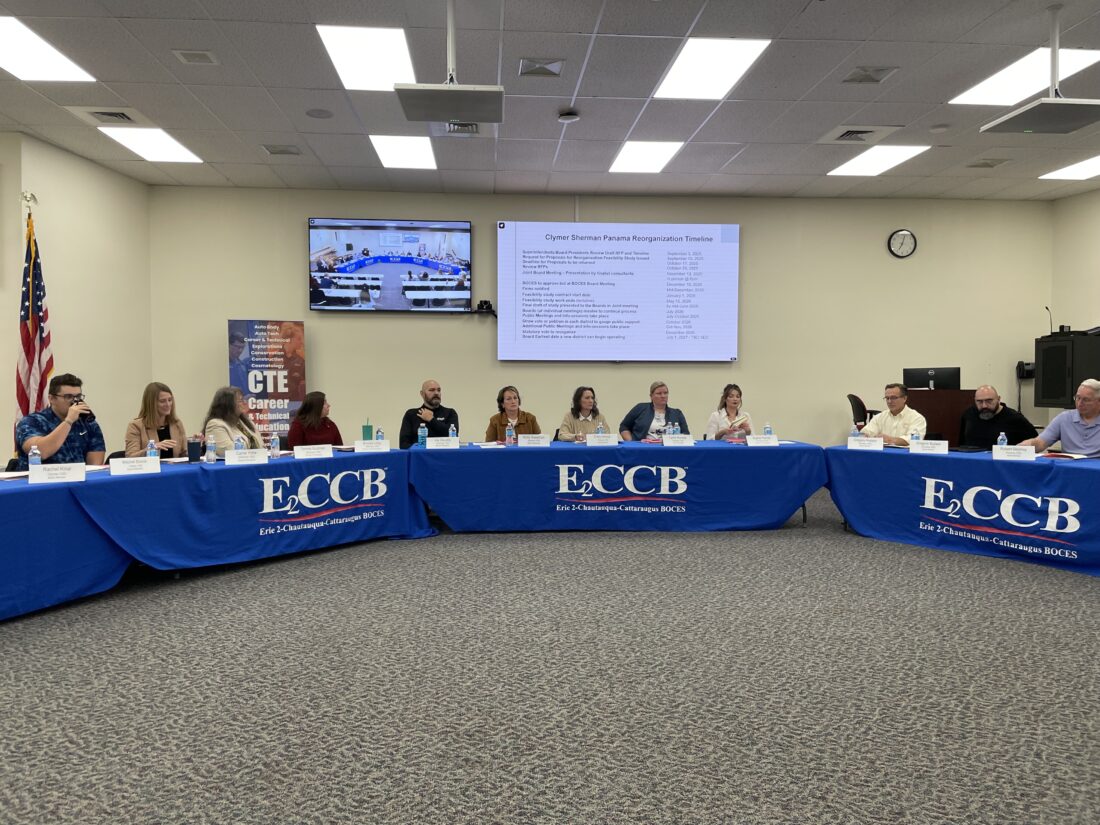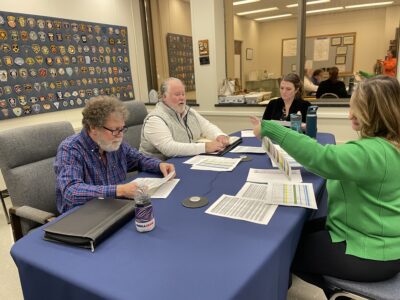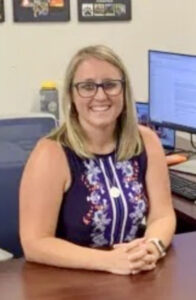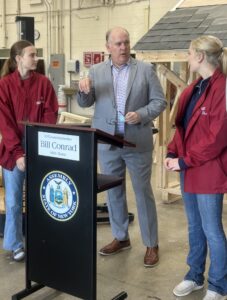Clymer, Sherman, Panama Hire Consulting Firm

The three school boards of Clymer, Sherman and Panama schools met for a second joint meeting as the merger feasibility study process continues to approve the hiring of a consultant firm to do the study. P-J photo by Sara Holthouse
ASHVILLE — The merger feasibility study to be done on a potential merger between Clymer, Sherman and Panama schools has taken another step forward as the three school boards approved a consulting firm to do the study.
The three boards along with members of the community and BOCES personnel gathered at the BOCES Hewes Center in Ashville for a second joint meeting to hear presentations from two finalist firms before officially approving one to hire to do the study.
According to a press release given to The Post-Journal by Shelly O’Boyle, CSP merger study project coordinator, the primary purpose of the comprehensive merger feasibility study is to provide the Boards of Education, district residents and taxpayers with objective data and expert analysis regarding the potential impacts of consolidating the three school systems. The study will thoroughly examine various aspects of a unified district, including projected educational programming enhancements, long-term financial implications, potential tax impacts, facility utilization, transportation logistics, and community feedback. The goal is to determine if a merger would offer improved educational opportunities and fiscal stability for students and residents across all three communities. The cost of the merger feasibility study is expected to be substantially offset by the New York State Local Government Efficiency Grant and/or BOCES Aid which maximizes efficiency and reduces local taxpayer burden.
The three school boards heard presentations Thursday night from White and Partners along with Western New York Educational Service Council. Both firms were given a 45-minute time frame, with 20 minutes to present and 25 minutes for interview questions from the school boards.
Beginning with White and Partners, the firm was introduced by Dan White, who is a project leader with Lynda Quick — who is also currently serving as interim superintendent at Frewsburg, which she noted has given her more perspective on Chautauqua County and is part-time, being four days a week starting in January. The team is made up of retired or recently retired superintendents and central office personnel. Other team members include Sharon Huff, Scott Covell, and Thomas Burns.
“This is really what we’re about, depth of experience, expertise in all areas, integrity of the process – transparency of that process is very, very important – and as we said caring for the schools, the community, and the individuals involved,” White said. “This is a human endeavor at the end of the day. I know you all know that, we understand that as we conduct this process.”
Looking at experience, the team members noted being involved in multiple successful mergers over the years in their various roles, also helping with implementation post-merger and being superintendents and administrators during other merger processes. Together the team brings multiple years of experience in various roles with schools, boards and communities that have gone through the merger process, including post-merger implementation and operations, which is something White said he felt was unique that they could bring to the table.
White and Partners also went over their process timeline, collaborative approach which included looking at things as interrelated or as a puzzle piece, with everything being connected, a kick-off process, data review, calendar, bi-weekly leadership meetings, a proposed steering committee made up of members of each individual community to meet on a monthly basis, and stakeholder and community engagement.
Quick noted calendar wise the calendar will always be flexible and if they need to add more to what they are doing they would. She added stakeholder and community engagement is at the heart of this process.
“To be successful in any process you have to engage your community, they have to know what’s happening, and they have to have regular communication,” Quick said. “So we will be working with you to make sure that’s going to happen every step along the way during this six-month process.”
Some of this planned stakeholder engagement includes an electronic survey or a hard-copy for people who cannot do electronic surveys, in person meetings, and focus groups. Superintendents and board presidents will be helping the firm to steer this process, as Quick said they know their own communities best. White and Partners also discussed the need to look at each school’s declining enrollment, what staffing and organization of a merged district would look like, and the impact of that, along with instructional programs, extracurriculars, facilities and food services, and reorganizational incentive aid. Following their presentation the three boards asked questions on items such as primary contact people, other commitments – to which White said this would be a priority for all, help after incentive aid expires, timeline, the effect it will have on communities, and a government efficiency grant that will be applied for. The previous unsuccessful merger between Clymer and Panama was also discussed.
“Every district has its own culture and climate; every region does and part of our role is to spend time in your communities, in your schools, with your families and kids and yourselves, your staff, understanding your culture and climate, your readiness to embark on this … we’ve been down this path before with a couple of districts,” Quick said. “We need to listen and learn what happened last time, that was part of it. We certainly read the study that was done, so we understand some context but you need to provide us with some additional context, because that’s important if there’s some additional things we need to do beyond in the communication aspect, the engagement aspect. We can learn in carving out more opportunities this time or perhaps not miss some of those things that were missed last time.”
The second presentation from Western New York Educational Service Council was done by Jeffrey Rabey. Rabey touched on similar aspects in his presentation, including establishing the boards’ collective aims, a joint steering team, having a clear definition, regular progress updates, neutral reporting, data and deliverables. They would be looking to engage the community through forums, focus groups, and community surveys as well, along with a community hub on all of the schools’ websites. Each aspect was broken out into phases set to appear in the final engagement report to be included in the final study.
“That will be important for any scenario development so you can see the community’s input,” Rabey said.
Rabey then touched on documentation and data for all facilities, utilization and future needs, cost analysis reports, other campus models, reports, deliverables, assessing programs and assets, including instructional, extracurriculars, transportation, food service and human resource programs. Rabey also looked at student data, instructional technology, long-term financial pictures and other data-based points and aspects, including sensitivity and risk taking.
“The objective here is to assess how key fiscal variables affect long-term sustainability and risk exposure,” Rabey said. “Here we would conduct a sensitivity analysis on variables and test multiple fiscal environments and we would break them up into three areas, conservative, moderate and optimistic, highlighting any potential risks tied to any formula changes, inflation or capital cost escalations and that would be a fiscal sensitivity and risk report included in that final analysis.”
Following a few more data points and how they would communicate the final report at the end of the study, along with study phases and data collection, the board moved into the interview questions session for this firm, asking the same questions as they did to the first. Rabey touched on his team being committed to the project, how they will be interacting with the boards throughout, the project timeline, and the amount of merger studies their team has done. They have done six merger studies — none in the last 10 years — with other numerous projects all over Western New York. Rabey and his team recognized the difficult moment that these three schools are facing in their history and the leadership they are showing throughout this process.
After both firms presented, the three school boards and BOCES personnel along with O’Boyle met for an executive session where it was decided to approve and move forward with White and Partners as the consultant firm for the merger feasibility study.
The next steps in the process is for the BOCES board to approve the bid for the study to White and Partners at their upcoming meeting on Dec. 10. Following approval at that meeting the firm will be notified in mid-December, with the feasibility study contract date to begin on Jan. 1 and end tentatively in May with the current plan for the final study presentation to be given to the boards in mid-June 2026.






